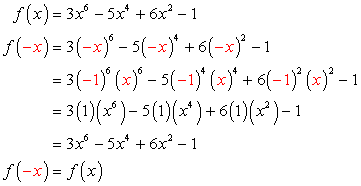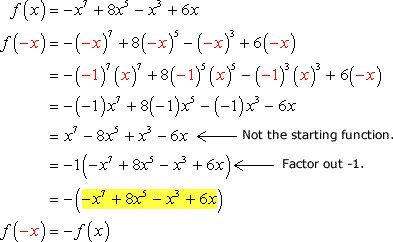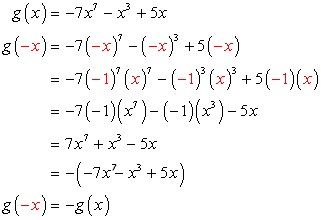How to Determine if a Function Is Odd Even or Neither
How to Determine if a Function is Even, Odd or Neither
I have prepared eight (8) worked examples to illustrate the procedure or steps on how to figure out if a given function is even, odd, or neither. The math involved in the calculation is easy as long as you are careful in every step of your solution.
To get into the "heart" of this topic, study the illustration below.

How to Tell if a Function is Even, Odd, or Neither
Let us talk about each case.
CASE 1: Even Function
Given some "starting" function f\left( x \right):

- If we evaluate or substitute \color{red}-x into f\left( x \right) and get the original or "starting" function again, this implies that f\left( x \right) is an even function.
CASE 2: Odd Function
Given some "starting" function f\left( x \right):

- However, if we evaluate or substitute \color{red}-x into f\left( x \right) and get the negative or opposite of the "starting" function, this implies thatf\left( x \right) is an odd function.
CASE 3: Neither Even nor Odd Function
Given some "starting" function f\left( x \right):

- If we evaluate or substitute \color{red}-x into f\left( x \right) and we don't obtain either Case 1 or Case 2, that implies f\left( x \right) is neither even nor odd. In other words, it does not fall under the classification of being even or odd.
Examples of How to Determine Algebraically if a Function is Even, Odd, or Neither
Example 1: Determine algebraically whether the given function is even, odd, or neither.
f\left( x \right) = 2{x^2} - 3
I start with the given function f\left( x \right) = 2{x^2} - 3, plug in the value \color{red}-x and then simplify. What do I get? Let us work it out algebraically.

Since f\left( { {\color{red}- x}} \right) = f\left( x \right), it means f\left( x \right) is an even function!
The graph of an even function is symmetric with respect to the y-axis or along the vertical line x = 0. Observe that the graph of the function is cut evenly at the y-axis and each half is an exact mirror of the another. Another way of describing it is that each half of the function is a reflection across the y-axis.
See the animated illustration.

Example 2: Determine algebraically whether the given function is even, odd, or neither.
f\left( x \right) =\, - 3{x^3} + 2x
I will substitute \color{red}-x into the function f\left( x \right) = 3{x^3} + 2x, and then simplify.

How to Determine an Odd Function
Important Tips to Remember:
- If ever you arrive at a different function after evaluating \color{red}–x into the given f\left( x \right), immediately try to factor out −1 from it and observe if the original function shows up. If it does, then we have an odd function.
- The effect of factoring out −1 results in the switching of the signs of the terms inside the parenthesis. This is a key step to identify an odd function.
Now, since f\left( { {\color{red}- x}} \right) = - f\left( x \right), it implies that the original function f\left( x \right) is an odd function!
The graph of an odd function has rotational symmetry about the origin, or at the point \left( {0,0} \right). That means we cut its graph along the y-axis and then reflect its even half in the x-axis first followed by the reflection in the y-axis.
See the animated illustration.

Example 3: Determine algebraically whether if the function is even, odd, or neither:
f\left( x \right) = 3{x^6} - 5{x^4} + 6{x^2} - 1
Here I observed that the exponents of variable x are all even numbers, namely6,4, and 2. As for the constant term, I must add that it can also be expressed as - 1 = - 1{\color{blue}{x^0}} which has an even power of zero.
This characteristic of a function containing only even powers can likely result in an even function. However, we must show it algebraically. So here it goes.
Evaluating \color{red}-x into f\left( x \right), we have the following calculation.

It is clearly an even function!
Example 4: Determine whether the given function is even, odd, or neither:
f\left( x \right) =\, - {x^7} + 8{x^5} - {x^3} + 6x
In contrast to example 3 where the function has even powers, this one has odd powers which are 7, 5, 3, and 1. By now, I hope you're already seeing the pattern. This is more likely an odd function but we will verify.
Substituting \color{red}-x into the given f\left( x \right), and simplifying, we get:

After factoring out −1, the polynomial inside the parenthesis equals the starting function. It shows that this is an odd function!
Example 5: Determine whether the given function is even, odd, or neither:

This time I will show you an example of a function that is neither even nor odd. Are you ready?
- First, check if it is even. Do we have the case f\left( {\color{red}{ - x}} \right) = f\left( x \right)?

Definitely not an even function since f\left( {\color{red}{ - x}} \right) \ne f\left( x \right).
- Secondly, check if it is odd by showing f\left( {\color{red}{ - x}} \right) = - f\left( x \right).

Even after factoring out −1, I still don't get the original function.
This is not an odd function since f\left( {\color{red}{ - x}} \right) \ne - f\left( x \right).
- Conclusion: Since we reached the case where f\left( {\color{red}{ - x}} \right) \ne f\left( x \right) and f\left( {\color{red}{ - x}} \right) \ne - f\left( x \right), this function is neither even nor odd!
Example 6: Determine whether the given function is even, odd, or neither:

Solution:

Therefore, function g\left( x \right) is an odd function!
Example 7: Determine whether the given function is even, odd, or neither:

Solution:

Therefore, the function h\left( x \right) is neither!
Example 8: Determine whether the given function is even, odd, or neither:

Solution:

Therefore, function k\left( x \right) is an even function!
Practice with Worksheets
How to Determine if a Function Is Odd Even or Neither
Source: https://www.chilimath.com/lessons/intermediate-algebra/even-and-odd-functions/
0 Response to "How to Determine if a Function Is Odd Even or Neither"
Post a Comment